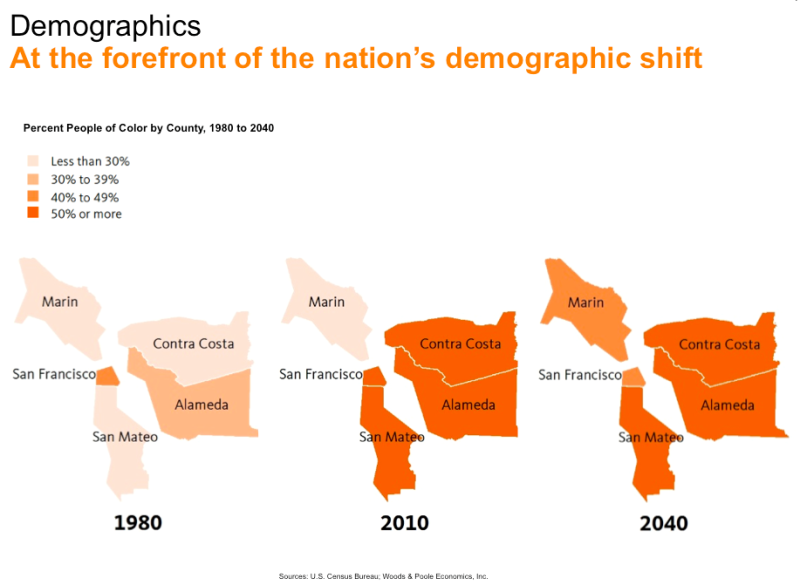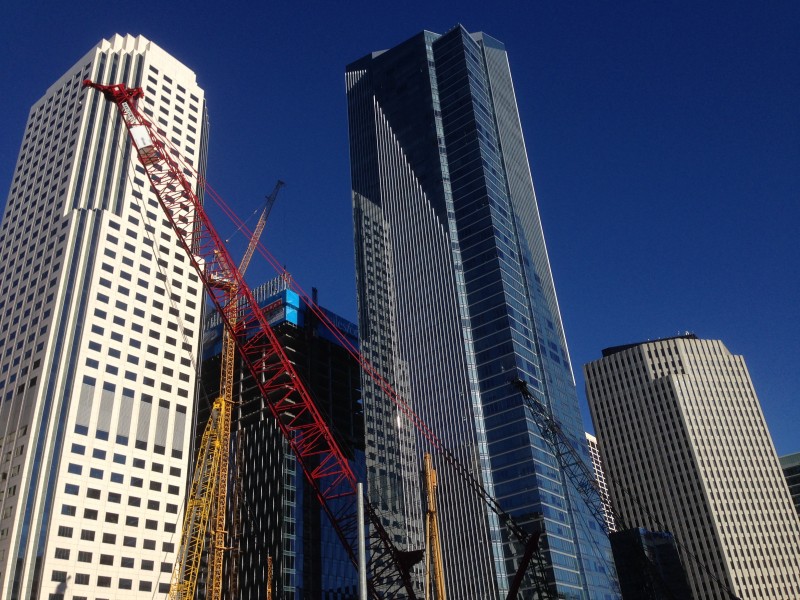San Francisco is the only one of the five central Bay Area counties where ethnic and racial diversity will actually decrease.
"It is a story about gentrification and rising housing costs and wages not keeping up," says Treuhaft. These parallel trends, with the tech boom as a backdrop, translate into an exodus of families and lower-income and working-class people.
She adds that the percentage of young people in San Francisco who are white jumped to 33 percent in 2014, compared with 22 percent in 1990 -- an unusual trend in the Bay Area.

The study is just the latest piece of evidence chronicling the huge shifts in San Francisco and the five-county Bay Area, which ranks second in diversity nationwide, trailing only the Vallejo-Fairfield area. Titled "An Equity Profile of the San Francisco Bay Area Region," the report offers a demographic portrait over the decades.
In 1980, the region did not have a single county that was majority people of color, and San Francisco County had the highest percentage people of color. Now, all counties except for Marin are majority people of color. By 2040, the percentage people of color is projected to decline in San Francisco while it continues to rise in Marin. In 2040, seven in every 10 San Mateo, Alameda and Contra Costa County residents are expected to be people of color.
"I was surprised and disappointed to see that divergence with San Francisco," Treuhaft says. "I was also surprised to see the extent of racial and gender inequities by wages."
The report, which was prepared for the San Francisco Foundation, draws on data from public and private sources, including the U.S. Census Bureau and the U.S. Bureau of Labor Statistics.
Among its findings:
- There has been dramatic growth and change in the Bay Area in the past 35 years, with people of color increasing from 34 percent to 58 percent of the population.
- A large racial generation gap exists between the region's mainly white senior citizens and increasingly diverse young population.
- The Bay Area has grown from 3.3 million to 4.3 million residents since 1980, with people of color contributing 97 percent of the growth in the 1980s and all the growth in the 1990s and 2000s.
- Immigration played a bigger role in the increase of the region's Asian population -- 52 percent from foreign-born residents -- than its Latino population, of which only 26 percent were not born in the United States.
- By 2040, 69 percent of Bay Area residents are projected to be people of color, making the region No. 19 among the 150 largest metros for share of the nonwhite population.
- College-educated women of color with a bachelor's degree or higher earn $14 an hour less than their white male counterparts.
Income inequality has risen dramatically all over the Bay Area in the last few decades -- more so than the United States as a whole -- to the point where it's now 14th among the country's 150 largest metro regions, up from 45th position in 1979. The wages of the highest-paid workers have increased significantly, while those of the lowest-paid workers have declined, the report says.
In addition, the unemployment rate is much higher for people of color, and more than one in four people without jobs live in neighborhoods where at least 82 percent of residents are nonwhite.
The study found that the percentage of Bay Area households with middle-class incomes has shrunk since 1979 -- from 40 to 36 percent -- but they've become more racially and ethnically diverse. About one in every nine Bay Area residents lives below the poverty line.
Meanwhile, high-wage workers have flourished: Incomes have more than doubled for those with jobs in professional and technical services and finance, the report says.
As far as being prepared for the future, the Bay Area will be facing a skills gap unless education levels increase, according to the study: "By 2020, 43 percent of the state's jobs will require an associate degree or above. Only 38 percent of U.S.-born Latinos, 35 percent of blacks, 31 percent of Native Americans and 14 percent of Latino immigrants have that level of education."
Other tidbits from the report: The Bay Area is less dependent on cars than almost anywhere else in the country. Poverty has increased faster in the suburbs. Segregation is steadily decreasing. And half of Bay Area renters spend more than 30 percent of their income on housing.
For people like Treuhaft, the flood of data takes on personal meaning.
She and her husband, who live near 24th Street in the Mission with their 2-year-old son, had hoped to buy a house in the neighborhood. But at this point they know that's simply delusional.
"We've seen housing prices increase beyond our means," says Treuhaft, who grew up in Ohio. "If my family was evicted now, we couldn't even afford to rent in the Mission."
She's dismayed by the study's predictions for what San Francisco will become. But they are, after all, only projections.

